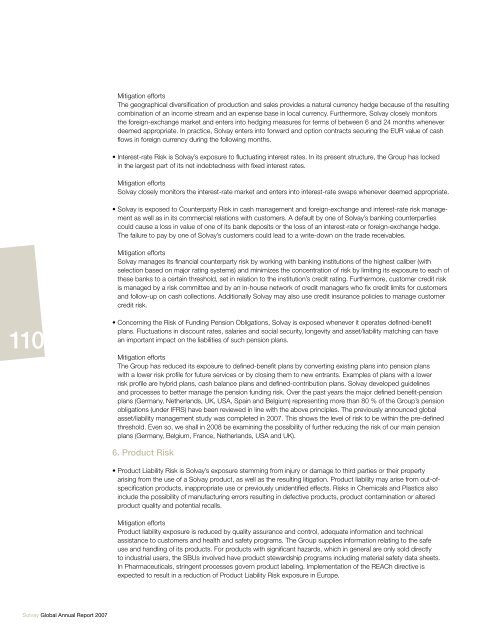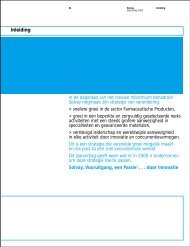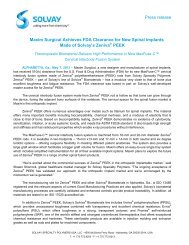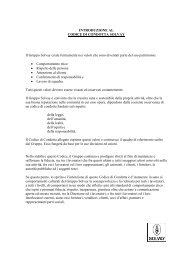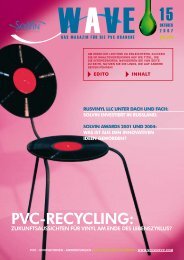+1 - Solvay
+1 - Solvay
+1 - Solvay
Create successful ePaper yourself
Turn your PDF publications into a flip-book with our unique Google optimized e-Paper software.
Mitigation efforts<br />
The geographical diversification of production and sales provides a natural currency hedge because of the resulting<br />
combination of an income stream and an expense base in local currency. Furthermore, <strong>Solvay</strong> closely monitors<br />
the foreign-exchange market and enters into hedging measures for terms of between 6 and 24 months whenever<br />
deemed appropriate. In practice, <strong>Solvay</strong> enters into forward and option contracts securing the EUR value of cash<br />
flows in foreign currency during the following months.<br />
• Interest-rate Risk is <strong>Solvay</strong>’s exposure to fluctuating interest rates. In its present structure, the Group has locked<br />
in the largest part of its net indebtedness with fixed interest rates.<br />
Mitigation efforts<br />
<strong>Solvay</strong> closely monitors the interest-rate market and enters into interest-rate swaps whenever deemed appropriate.<br />
• <strong>Solvay</strong> is exposed to Counterparty Risk in cash management and foreign-exchange and interest-rate risk management<br />
as well as in its commercial relations with customers. A default by one of <strong>Solvay</strong>’s banking counterparties<br />
could cause a loss in value of one of its bank deposits or the loss of an interest-rate or foreign-exchange hedge.<br />
The failure to pay by one of <strong>Solvay</strong>’s customers could lead to a write-down on the trade receivables.<br />
Mitigation efforts<br />
<strong>Solvay</strong> manages its financial counterparty risk by working with banking institutions of the highest caliber (with<br />
selection based on major rating systems) and minimizes the concentration of risk by limiting its exposure to each of<br />
these banks to a certain threshold, set in relation to the institution’s credit rating. Furthermore, customer credit risk<br />
is managed by a risk committee and by an in-house network of credit managers who fix credit limits for customers<br />
and follow-up on cash collections. Additionally <strong>Solvay</strong> may also use credit insurance policies to manage customer<br />
credit risk.<br />
110<br />
• Concerning the Risk of Funding Pension Obligations, <strong>Solvay</strong> is exposed whenever it operates defined-benefit<br />
plans. Fluctuations in discount rates, salaries and social security, longevity and asset/liability matching can have<br />
an important impact on the liabilities of such pension plans.<br />
Mitigation efforts<br />
The Group has reduced its exposure to defined-benefit plans by converting existing plans into pension plans<br />
with a lower risk profile for future services or by closing them to new entrants. Examples of plans with a lower<br />
risk profile are hybrid plans, cash balance plans and defined-contribution plans. <strong>Solvay</strong> developed guidelines<br />
and processes to better manage the pension funding risk. Over the past years the major defined benefit-pension<br />
plans (Germany, Netherlands, UK, USA, Spain and Belgium) representing more than 80 % of the Group’s pension<br />
obligations (under IFRS) have been reviewed in line with the above principles. The previously announced global<br />
asset/liability management study was completed in 2007. This shows the level of risk to be within the pre-defined<br />
threshold. Even so, we shall in 2008 be examining the possibility of further reducing the risk of our main pension<br />
plans (Germany, Belgium, France, Netherlands, USA and UK).<br />
6. Product Risk<br />
• Product Liability Risk is <strong>Solvay</strong>’s exposure stemming from injury or damage to third parties or their property<br />
arising from the use of a <strong>Solvay</strong> product, as well as the resulting litigation. Product liability may arise from out-ofspecification<br />
products, inappropriate use or previously unidentified effects. Risks in Chemicals and Plastics also<br />
include the possibility of manufacturing errors resulting in defective products, product contamination or altered<br />
product quality and potential recalls.<br />
Mitigation efforts<br />
Product liability exposure is reduced by quality assurance and control, adequate information and technical<br />
assistance to customers and health and safety programs. The Group supplies information relating to the safe<br />
use and handling of its products. For products with significant hazards, which in general are only sold directly<br />
to industrial users, the SBUs involved have product stewardship programs including material safety data sheets.<br />
In Pharmaceuticals, stringent processes govern product labeling. Implementation of the REACh directive is<br />
expected to result in a reduction of Product Liability Risk exposure in Europe.<br />
<strong>Solvay</strong> Global Annual Report 2007


